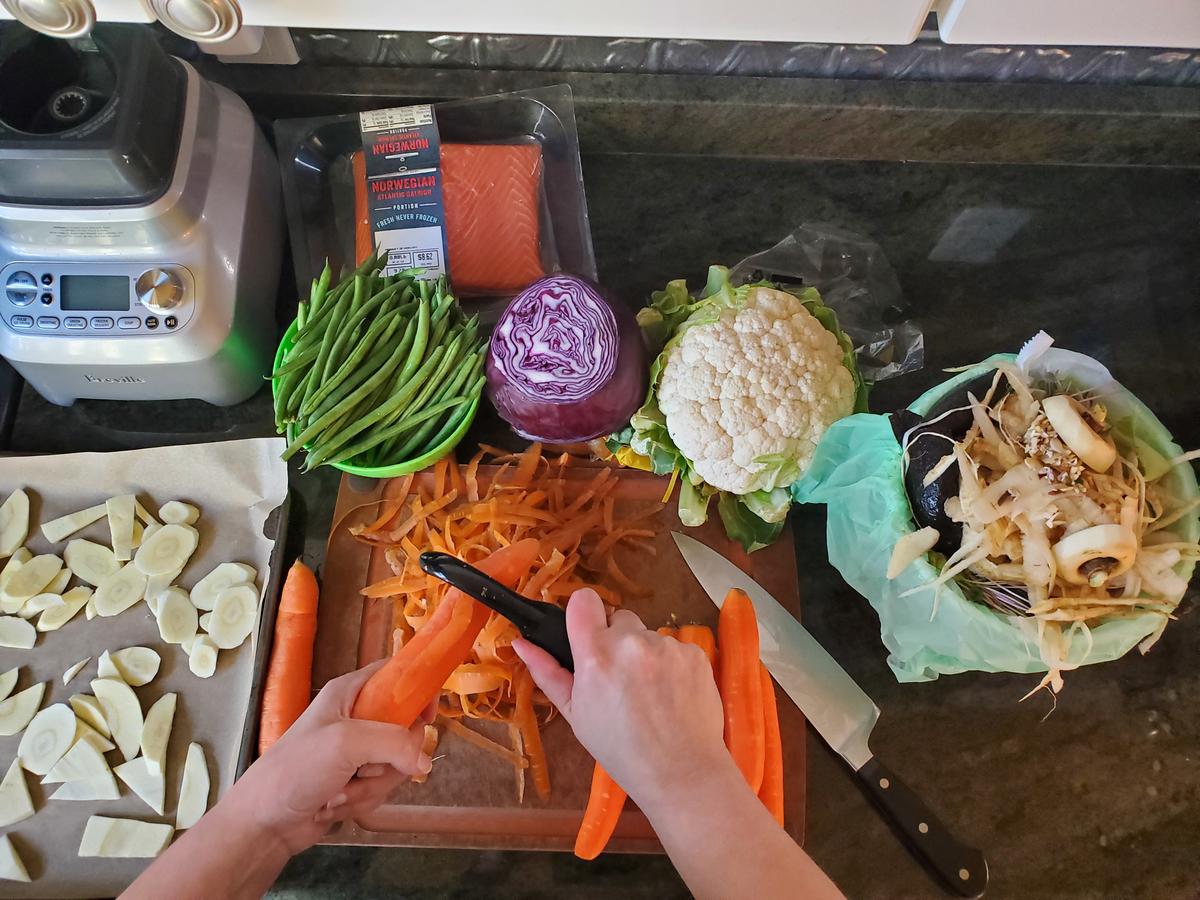Editor's Note: Tiffany Sprague is NRRI's Sustainability Coordinator, helping us live out our best sustainable lives at work and at home. This is her monthly blog.
Three months into 2022 and how are you doing on your New Year’s resolution? For many of us, we hope this will be the year we finally regain our unobtainable high school bod. Oh, the days of casually running a six-minute mile after lunch then popping into history class like nothing happened. Very different from my now post-nap, “brisk” (aka slow mosey) walk around the block.
Crossfit, eight hours of sleep, gratitude journals, kale (so.much.kale) and lean protein for days – all the things to make us superhuman. And when superhumans whip up those taste- and delicious-free meals, kale stems start flying, carrot peels somehow become ingrained in the kitchen floor, and the garbage bag now overflows with food scraps. If you are feeling a bit lost on ways to improve the food waste situation at home, keep reading to become a food waste reduction warrior in four easy steps!
Step 1: Compost Scraps
In essence, composting is about creating a hot, steamy environment for food scraps to break down and turn into beautiful soil-like nutrients for plants to thrive. Check with your local sanitary district to see if they offer commercial composting and what restrictions they may have. This is a great option if you are looking for convenience or don’t have the space to set up at home composting. Many commercial facilities also accept meat, dairy and fat, which is usually not recommended for home composters. The EPA offers a great starter resource for composting at home, including maintaining an indoor worm bin for the more adventurous composters.
Step 2: Save Scraps & Make Broth
As you prep your sad – I mean, beautiful, rainbow-colored, healthy – meals, place clean scraps and peels in a freezer bag. Place the bag in the freezer, and simply add in more scraps over time. Once you have a full bag or two, empty the bags into a pot with some water, simmer for a few hours, strain it and you have delicious golden liquid. Pro tip: wash

your gallon freezer bag, label it as veggie scraps, and reuse it! When the bag has fallen apart, rinse it out, let it dry completely, rip off and throw away the zipper top, and recycle the bag with plastic bag recycling.
Step 3: Store Veggies the Right Way
Ah, the great struggle of all time. You want salad. You love (hate) salad. New year, new you, all that jazz. But now the salad is very wilty and your high school body dream is slowly slipping away with each passing composted salad.
To keep lettuce fresh longer: line a damp cloth inside an airtight container, place greens on top, place a dry cloth on top of greens, put on lid, place in fridge. The cloth could be a paper towel, but naturally you reached for one of your small, reusable cloths, correct?
The New York Times has a great Wirecutter article on ways to keep produce fresh, with a fantastic chart you could print out and post to the fridge.
Step 4: Plan Your Way to Reduced Food Waste
It really is the pits when you are casually strolling the aisles at the grocery store and angsty food on the shelves just start jumping into the shopping cart. We’ve all been there I’m sure. Protect your grocery cart, and ultimately our landfills, by making a plan before shopping for more food. Inventory the pantries and fridges at home. Yes, including that creepy chest freezer in the basement.
Then, get honest with how many meals you’ll likely eat out that week (#NoShame). After scouring the internet for taste-free meals, and doing math gymnastics in your head of how many meals you need to make (don’t forget to account for leftovers), what you have in your supply (which I suspect is more than you realize), and what you need for your recipes, you’re ready to make a realistic game plan for your grocery haul that week.
Once you’ve successfully avoided the tempting grocery store goodies and you’re safely back in the kitchen, spend a few moments slicing and dicing as much fresh produce as possible. The more you have ready to go, the easier, and more successful, meal prep is likely to go for the remainder of the week. And the more you eat up those delicious veggies, the less food waste you produce, and the closer you get to six-pack abs and reliving your high school youth.
Just remember, do the one thing you can do right now. There is no right or wrong. Eventually, that one thing will feel like second nature, and you can add in a second thing. Soon, you'll be sauteing kale stems, your trash can will shrink in size, and you won't even remember how it all started for you.
Bonus: Tiff’s Recipe for Bone Broth
Roasted a bird and not sure what to do with the carcass? While commercial composting may be an option, another great option is to make broth!
2 chickens or 1 turkey (bones and skins)
1 large onion, rough chop
1 head garlic, cut in half (yep, skins still on)
4 celery stalks, rough chop
3 carrots, rough chop
4 springs fresh thyme
3 sprigs fresh rosemary
1 bunch fresh parsley
2 teaspoons whole black peppercorns
2 bay leaves
2 teaspoons sea salt
16 cups water
1 tablespoon raw apple cider vinegar
Place everything in a stock pot (at least 8 qt pot needed), cover, bring to boil, reduce heat to low and simmer for 6-8 hours. Strain and compost food scraps. Refrigerate stock for 5 days or freeze for longer.
Similar to veggie scraps, after roasting your bird, place *cooled* carcass into a freezer bag and save for when you are ready to make stock. I find one chicken will fit into a freezer bag whole, and one ~16 lb turkey will take 2 freezer bags, with the carcass disassembled. You can place the frozen carcass directly into the pot - no need to thaw!
